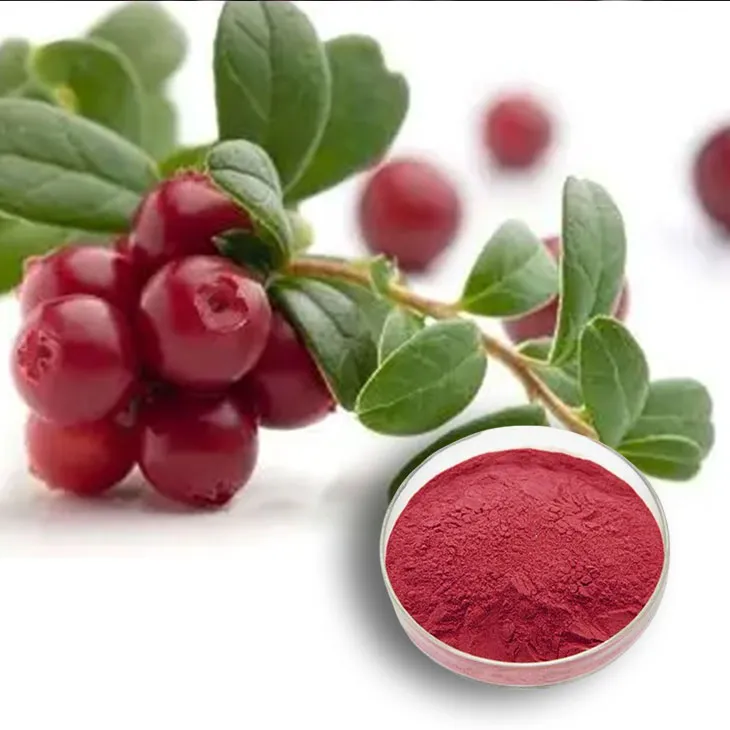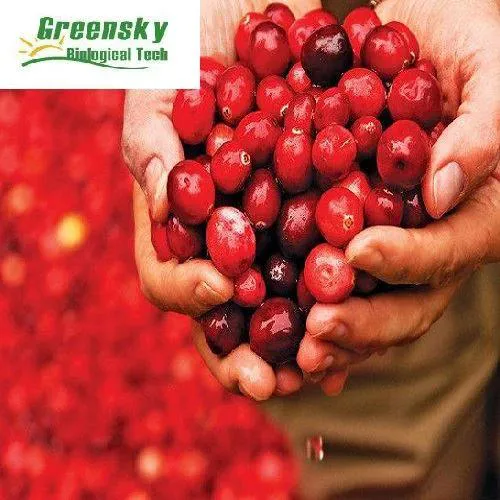- 0086-571-85302990
- sales@greenskybio.com
Cranberry Extract: From Leaves to Extraction
2024-11-12

1. Introduction
Cranberry Extract is a substance that has been garnering increasing attention in recent years. It is not only known for its potential health benefits but also has significance in various industries. In this article, we will embark on a comprehensive exploration, starting from the very origin of cranberries, delving into the properties of their leaves, and closely following the extraction process. Moreover, we will also take a look at the scientific research associated with Cranberry Extract and its far - reaching impact on human health as well as its importance in different fields.

2. The Origin of Cranberries
Cranberries are native to North America. They are typically found in bogs and wetlands. These areas provide the ideal growing conditions for cranberries, with their acidic soil and ample water supply. Cranberries are a member of the Vaccinium genus, which also includes blueberries and bilberries.
Native Americans were the first to discover and utilize cranberries. They used cranberries not only as a food source but also for medicinal purposes. For example, they used cranberries to treat various ailments such as urinary tract infections. This traditional use of cranberries has laid the foundation for modern research into its health - promoting properties.

3. Properties of Cranberry Leaves
3.1 Nutritional Components
Cranberry leaves are rich in various nutrients. They contain vitamins such as vitamin C, which is an important antioxidant. Antioxidants play a crucial role in protecting the body against free radical damage. In addition, cranberry leaves also contain minerals like potassium and magnesium. Potassium is essential for maintaining proper heart function and fluid balance in the body, while magnesium is involved in numerous biochemical reactions in the body.
3.2 Phytochemicals
Cranberry leaves are a rich source of phytochemicals. One of the most notable phytochemicals is flavonoids. Flavonoids have antioxidant, anti - inflammatory, and anti - microbial properties. Another important group of phytochemicals in cranberry leaves is phenolic acids. These phenolic acids contribute to the overall antioxidant capacity of cranberry leaves and may also have anti - cancer properties.

4. The Extraction Process
4.1 Harvesting of Cranberry Leaves
The first step in the extraction process is the harvesting of cranberry leaves. This is typically done during the appropriate season when the leaves are at their peak in terms of nutrient and phytochemical content. The leaves are carefully picked to avoid damage, as damaged leaves may lead to a decrease in the quality of the extract.
4.2 Drying of Cranberry Leaves
After harvesting, the cranberry leaves need to be dried. Drying helps to preserve the leaves and also concentrates the nutrients and phytochemicals. There are different methods of drying, such as air drying and oven drying. Air drying is a more natural method, but it may take longer. Oven drying, on the other hand, can be more controlled in terms of temperature and humidity, but it requires careful monitoring to avoid over - drying the leaves.
4.3 Extraction Methods
There are several methods for extracting substances from cranberry leaves. One common method is solvent extraction. In solvent extraction, a suitable solvent such as ethanol or water is used to dissolve the desired compounds from the dried leaves. The choice of solvent depends on the nature of the compounds to be extracted. For example, ethanol is often used for extracting lipophilic compounds, while water is more suitable for hydrophilic compounds.
Another extraction method is supercritical fluid extraction. This method uses supercritical fluids, such as supercritical carbon dioxide. Supercritical fluid extraction has the advantage of being a more "green" extraction method as it does not leave behind harmful residues. It also allows for more selective extraction of compounds.

5. Scientific Research on Cranberry Extract
5.1 Anti - microbial Properties
One area of significant scientific research on cranberry extract is its anti - microbial properties. Studies have shown that cranberry extract can inhibit the growth of certain bacteria, especially those associated with urinary tract infections, such as Escherichia coli. The mechanism by which cranberry extract exerts its anti - microbial effect is thought to be related to its ability to prevent bacteria from adhering to the cells lining the urinary tract.
5.2 Cardiovascular Health
Research has also been conducted on the impact of cranberry extract on cardiovascular health. Cranberry extract may help in reducing blood pressure and improving lipid profiles. The flavonoids in cranberry extract are believed to play a role in reducing oxidative stress in the blood vessels, which in turn can help in preventing the development of atherosclerosis.
5.3 Anti - cancer Potential
Some studies have suggested that cranberry extract may have anti - cancer potential. The phenolic acids and flavonoids in cranberry extract may be able to induce apoptosis (programmed cell death) in cancer cells. However, more research is needed in this area to fully understand the mechanisms involved and to determine the effectiveness of cranberry extract in cancer prevention and treatment.
6. Potential Impact on Human Health
6.1 Urinary Tract Health
As mentioned earlier, cranberry extract has long been associated with urinary tract health. It can be used as a natural alternative to antibiotics in the prevention and treatment of urinary tract infections. By preventing bacteria from adhering to the urinary tract, cranberry extract helps to keep the urinary tract clean and free from infection.
6.2 Digestive Health
Cranberry extract may also have benefits for digestive health. It can help in reducing inflammation in the gut and promoting the growth of beneficial gut bacteria. This can lead to improved digestion and absorption of nutrients, as well as a stronger immune system, since a large part of the immune system is located in the gut.
6.3 Skin Health
The antioxidant and anti - inflammatory properties of cranberry extract can also be beneficial for skin health. It can help in protecting the skin from damage caused by UV radiation and environmental pollutants. Cranberry extract may also be used in the treatment of certain skin conditions such as acne and eczema, due to its ability to reduce inflammation.
7. Significance in Different Fields
7.1 Food and Beverage Industry
In the food and beverage industry, cranberry extract is used as a natural flavoring agent and a functional ingredient. It can be added to juices, yogurts, and other food products to enhance their flavor and nutritional value. Cranberry - flavored products are popular among consumers, especially those who are health - conscious.
7.2 Pharmaceutical Industry
The pharmaceutical industry is also interested in cranberry extract due to its potential health benefits. It can be developed into dietary supplements or even used as a starting material for the development of new drugs. The anti - microbial, anti - inflammatory, and anti - cancer properties of cranberry extract make it a promising candidate for further pharmaceutical research.
7.3 Cosmetic Industry
In the cosmetic industry, cranberry extract is used in various skin care products. Its antioxidant and anti - inflammatory properties make it suitable for use in creams, lotions, and serums. Cranberry extract - based skin care products can help in improving skin texture, reducing wrinkles, and protecting the skin from environmental damage.
8. Conclusion
Cranberry extract, derived from cranberry leaves through a series of processes, is a substance with great potential. Its origin in North American bogs, the rich properties of its leaves, the various extraction methods, and the extensive scientific research on it all contribute to its significance in different fields. From its potential impact on human health, including urinary tract health, cardiovascular health, and skin health, to its applications in the food, pharmaceutical, and cosmetic industries, cranberry extract is a topic worthy of further exploration. As research continues, we can expect to see more in - depth understanding of cranberry extract and its potential benefits.
FAQ:
What are the main properties of cranberry leaves?
Cranberry leaves are rich in various bioactive compounds. They often contain phenolic acids, flavonoids, and other antioxidants. These components can play roles in antioxidant activities, which may help in protecting cells from oxidative damage. Also, they may have certain anti - inflammatory properties, potentially contributing to overall health.
How is cranberry extract obtained?
The extraction of cranberry extract typically involves several steps. First, the cranberries (including the leaves in some cases) are harvested. Then, they are usually dried to preserve their components. After that, extraction methods such as solvent extraction (using solvents like ethanol or water) are employed. The extract is then purified and concentrated to obtain the final cranberry extract product.
What is the potential impact of cranberry extract on human health?
Cranberry extract has several potential impacts on human health. It is well - known for its role in urinary tract health. It may help prevent urinary tract infections by preventing bacteria from adhering to the urinary tract walls. Additionally, it may have antioxidant effects in the body, which can be beneficial for reducing the risk of chronic diseases. Some studies also suggest it may have a positive impact on heart health by potentially reducing cholesterol levels.
What are the applications of cranberry extract in different fields?
In the medical field, as mentioned, it is used for urinary tract health and potentially for heart health support. In the food and beverage industry, cranberry extract is used as a natural flavoring agent and also as a functional ingredient due to its health - promoting properties. In the cosmetic industry, it can be found in products for its antioxidant properties, which may help in skin health and anti - aging.
Are there any side effects of cranberry extract?
While cranberry extract is generally considered safe for most people, there can be some side effects. In some cases, it may cause stomach upset, diarrhea, or allergic reactions in individuals who are sensitive to cranberries. Also, if consumed in large amounts, it may interact with certain medications, such as blood - thinning drugs.
Related literature
- Cranberry Extract: Composition, Bioactivities, and Health Benefits"
- "The Science behind Cranberry Leaves and Their Extracts"
- "Cranberry Extract: From Plant to Product - A Comprehensive Review"
- ▶ Hesperidin
- ▶ Citrus Bioflavonoids
- ▶ Plant Extract
- ▶ lycopene
- ▶ Diosmin
- ▶ Grape seed extract
- ▶ Sea buckthorn Juice Powder
- ▶ Fruit Juice Powder
- ▶ Hops Extract
- ▶ Artichoke Extract
- ▶ Mushroom extract
- ▶ Astaxanthin
- ▶ Green Tea Extract
- ▶ Curcumin
- ▶ Horse Chestnut Extract
- ▶ Other Product
- ▶ Boswellia Serrata Extract
- ▶ Resveratrol
- ▶ Marigold Extract
- ▶ Grape Leaf Extract
- ▶ New Product
- ▶ Aminolevulinic acid
- ▶ Cranberry Extract
- ▶ Red Yeast Rice
- ▶ Red Wine Extract
-
Plantain extract
2024-11-12
-
Motherwort Extract
2024-11-12
-
Medicinal Marshmallow Extract
2024-11-12
-
Beta Carotene
2024-11-12
-
Pine bark Extract Powder
2024-11-12
-
Baicalin
2024-11-12
-
Angelica sinensis extract
2024-11-12
-
Cat Claw Extract
2024-11-12
-
Sophora Flavescens Root Extract
2024-11-12
-
Maitake Mushroom Extract
2024-11-12





















